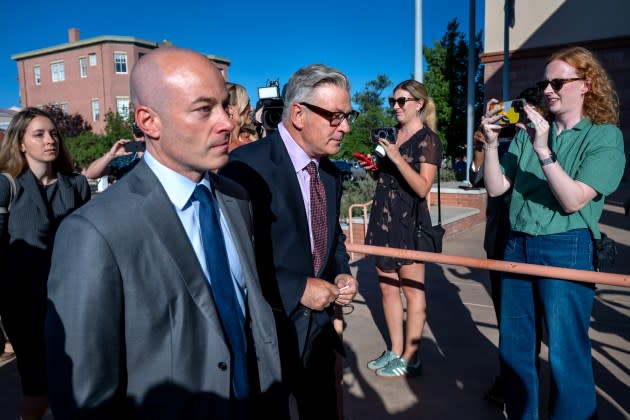Alec Baldwin Broke ‘Cardinal Rules’ of Gun Safety While Playing ‘Make Believe,’ Prosecutor Says

SANTA FE, N.M. — A prosecutor told jurors Wednesday that Alec Baldwin violated the cardinal rules of gun safety while playing “make believe” on the set of “Rust,” resulting in the death of cinematographer Halyna Hutchins.
Erlinda Ocampo Johnson, one of two special prosecutors on the case, argued in her opening statement that Baldwin repeatedly violated film industry gun protocols in the days leading up to the fatal shooting. She also faulted him for failing to check his gun with armorer Hannah Gutierrez Reed, who had mistakenly loaded it with a live bullet.
More from Variety
'Rust' Trial: Jurors Won't Hear About Alec Baldwin's Role as a Producer
Alec Baldwin on Trial: Is the Actor to Blame for a Fatal Shooting on Set?
“The defendant didn’t do a gun safety check with that inexperienced armorer,” Johnson said. “He pointed the gun at another human being, cocked the hammer and pulled the trigger in reckless disregard for Ms. Hutchins’ safety.”
In his opening statement, defense attorney Alex Spiro argued that it was not Baldwin’s responsibility to check the gun, and that he relied on others — Gutierrez Reed and first assistant director Dave Halls — to make sure the gun was safe.
“The actor’s job is to act,” he said. “He’s Harland Rust. He’s an outlaw. In the incident in question, he’s pulling a six-shooter to defend himself. His mind is somewhere else: in the being of another, a century away. He’s an outlaw protecting himself.”
Baldwin’s trial got underway Wednesday, nearly three years after Hutchins was accidentally killed in a church building at the Bonanza Creek Ranch in October 2021.
Baldwin sat at the defense table, with dark-framed glasses and close-cropped hair. When Spiro showed outtakes from the scene in the church, he leaned forward to watch his performance with his hand on his chin.
In their opening statements, both the prosecution and the defense talked about Baldwin’s Colt .45, which will be a major focus of the trial, and about the industrywide safety bulletins for gun use on set.
Johnson showed the jurors an image of the Italian-made replica, saying that Baldwin had asked for “the biggest gun available.” She said that the trial will show that the gun was working properly at the time of the shooting, dispelling the defense claim that Baldwin did not pull the trigger.
Spiro argued that the FBI had destroyed the gun during testing, depriving the defense of an opportunity to examine it for defects. But he also argued that even if Baldwin did pull the trigger, he would still not be guilty of involuntary manslaughter.
“On a movie set, you’re allowed to pull the trigger,” Spiro said.
The two sides disagreed on what rules actually apply on set. Johnson noted that Safety Bulletin #1 requires treating guns as if they are loaded, and forbids pointing a gun at anyone.
But Spiro pointed out that actors in Westerns routinely point guns at others while filming scenes.
“These cardinal rules, they’re not cardinal rules on a movie set… People point guns on movie sets,” Spiro said. “For acting to work, you have to be so close to the barrier of real and imagined that the viewer feels that it’s real.”
Spiro noted that Baldwin had been assured that the gun was “cold” — meaning it did not contain a charge. He said that no one in the church had any idea that it contained a live bullet.
“it’s impossible, literally impossible for a cold gun to hurt somebody,” he said. “It could hurt you more by dropping it on your foot.”
Spiro also argued that the investigators had failed to figure out the source of the live bullet. So at a certain point, he argued, they turned their attention to proving that Baldwin fired the gun.
“They weren’t really investigating anymore,” Spiro said. “They were trying to disprove Alec, to get Alec, to have this day.”
Baldwin’s wife Hilaria and brother Stephen sat behind him in the gallery. Gloria Allred, the attorney who represents Hutchins’ parents and sister, sat in the front row on the opposite side. She carried a framed photo of Hutchins with her mother, Olga Solovey, and her son Andros.
One of the key witnesses at the trial will be Joel Souza, the film’s director, who was wounded in the shoulder. In her opening statement, Johnson said that Souza would testify that Baldwin often went off-script.
“You will hear the director tell you, many times the defendant did his own thing,” Johnson said.
She argued that in the fatal incident, Baldwin was supposed to draw his gun from the holster, but was not supposed to fire. She said that witnesses saw him repeatedly put his finger on the trigger, in violation of the rules, and that he would sometimes cock the gun for no reason.
“The evidence will show that like in many workplaces, there are people who act in a reckless manner and place other individuals in danger and act without due regard for the safety of others,” she said. “That, you will hear, was the defendant, Alexander Baldwin.”
After opening statements, the prosecution called Deputy Nicholas Lefleur, one of the first officers on scene. The state played his lapel camera video, which showed medics frantically trying to save Hutchins’ life after she was shot. Lefleur testified at the involuntary manslaughter trial of Gutierrez Reed in February, and his lapel video was also played for the jury in that case.
Best of Variety
Sign up for Variety’s Newsletter. For the latest news, follow us on Facebook, Twitter, and Instagram.

